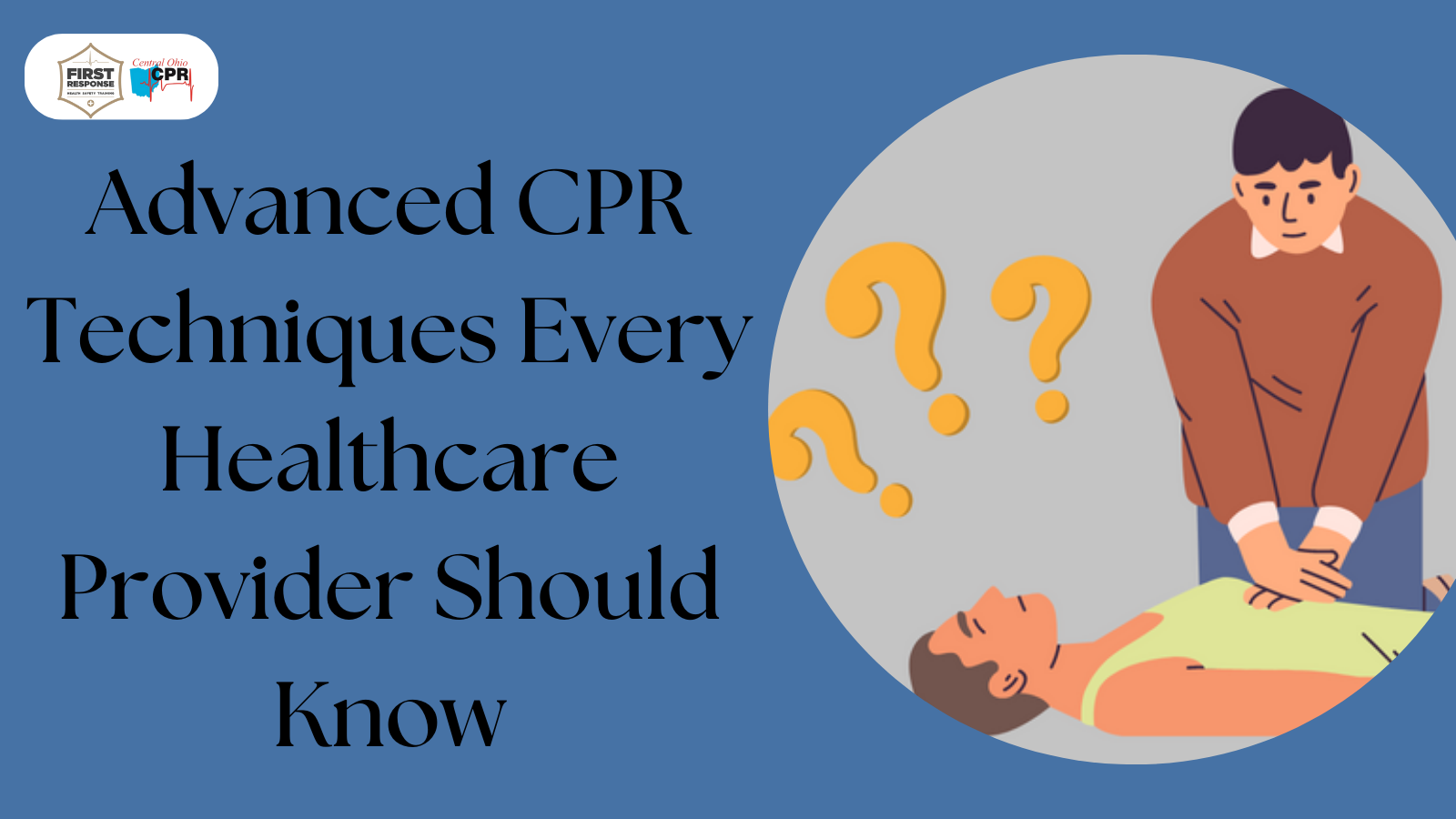Cardiopulmonary resuscitation (CPR) is one of the most essential life-saving skills in the healthcare profession. While most people are familiar with the basic steps of CPR, healthcare providers are required to have a deeper understanding of advanced techniques. This knowledge can be crucial in high-pressure situations where seconds matter.
If you’re a healthcare provider in Central Ohio, whether you’re working in hospitals, clinics, or emergency settings, staying updated on the latest advancements in CPR techniques can mean the difference between life and death.
In this blog, we will explore the critical advanced CPR techniques every healthcare provider should know, including the importance of certification and the role of organizations like the American Heart Association (AHA).
Understanding the Basics of CPR for Healthcare Providers
Before diving into advanced techniques, it’s essential to have a solid understanding of basic life support (BLS). The American Heart Association (AHA) emphasizes the importance of learning BLS as the foundation for advanced resuscitation efforts. BLS includes performing high-quality chest compressions, ensuring airway patency, and delivering effective breaths.
For healthcare providers, BLS is more than a fundamental skill—it’s a requirement. Whether you’re in Columbus or anywhere across Central Ohio, it is critical that you regularly renew your CPR certification online or through in-person courses. The AHA provides excellent resources for both learning and certification. Many employers even require CPR for healthcare providers’ certification to ensure all staff is prepared to handle cardiac emergencies.
Importance of High-Quality Chest Compressions
One of the most critical aspects of advanced CPR is delivering high-quality chest compressions. While basic CPR guidelines instruct on the depth and rate of compressions, healthcare providers are expected to perform with even greater precision. Research has shown that chest compressions at the correct depth (at least two inches for adults) and rate (100-120 compressions per minute) dramatically improve survival rates.
Why is this important?
In real-world scenarios, distractions, fatigue, and chaotic environments can interfere with proper technique. This is where advanced skills come into play. Healthcare providers are trained to adapt and maintain high-quality compressions even in challenging situations, such as when a patient is on a stretcher or in a confined space.
Healthcare workers in CPR Columbus training programs are often taught to switch rescuers frequently to prevent fatigue, which is crucial for maintaining consistent compression depth and rate. Advanced CPR training also teaches how to monitor feedback devices that measure compression quality in real-time, providing essential data that can guide rescuers in adjusting their efforts.
Airway Management Techniques
In basic CPR, opening the airway is usually done by tilting the head and lifting the chin. However, for healthcare providers, advanced airway management is essential, especially in patients with severe trauma, obesity, or anatomical challenges. Managing the airway involves more than just basic maneuvers—it often requires tools and techniques that go beyond what is taught in BLS courses.
For healthcare providers, knowledge of advanced airway techniques such as the use of supraglottic airway devices, bag-valve masks, and endotracheal intubation is critical. Proper use of these devices helps ensure that oxygen is delivered effectively to the lungs and improves overall patient outcomes.
Training courses like CPR for healthcare providers often include hands-on experience with these advanced tools, ensuring that healthcare professionals in Central Ohio CPR programs are equipped with the knowledge and confidence to perform in real-life emergency situations.
Advanced Defibrillation Techniques
Defibrillation, or the delivery of an electric shock to the heart, is a crucial component of advanced CPR. Automated External Defibrillators (AEDs) are now a common sight in many public areas, but healthcare providers must be proficient in using more advanced defibrillation equipment. In cases of ventricular fibrillation or pulseless ventricular tachycardia, immediate defibrillation can be life-saving.
Healthcare providers in CPR Columbus programs are trained to recognize when defibrillation is needed and how to use advanced devices such as manual defibrillators, which allow for more precise control over the shock delivered. They must also be capable of interpreting electrocardiograms (ECGs) to determine the most appropriate timing and energy levels for defibrillation.
Why is this crucial?
Proper timing and execution of defibrillation can significantly increase the likelihood of restoring a regular heart rhythm. In advanced CPR, defibrillation is often performed in conjunction with drug administration and airway management, making it a key part of the broader resuscitation effort.
Drug Administration in Advanced CPR
While basic CPR focuses on chest compressions and breathing, advanced CPR involves the administration of drugs to support resuscitation efforts. Epinephrine, amiodarone, and other medications are often used to treat underlying causes of cardiac arrest, such as abnormal heart rhythms or electrolyte imbalances.
Healthcare providers are trained to understand the indications for these medications, as well as the proper dosages and routes of administration. During advanced CPR certification online courses, professionals learn how to deliver these drugs effectively, often through intravenous (IV) or intraosseous (IO) routes. The administration of these medications must be carefully timed with chest compressions and defibrillation to maximize their effectiveness.
Key takeaway:
Advanced CPR requires a thorough understanding of pharmacology, as the right medication at the right time can dramatically improve a patient’s chances of survival.
CPR Certification for Healthcare Providers
For healthcare providers, maintaining up-to-date CPR certification is non-negotiable. The AHA offers CPR certification online and in-person, making it easier than ever for busy healthcare professionals to stay certified. In Central Ohio CPR classes, healthcare providers can refine their skills in both basic and advanced CPR, ensuring that they are ready to respond when needed.
Healthcare providers in CPR Columbus can also take advantage of specialized AHA courses, such as Advanced Cardiovascular Life Support (ACLS) and Pediatric Advanced Life Support (PALS). These programs go beyond basic CPR and focus on the specific needs of adult and pediatric patients in cardiac emergencies.
Why is ongoing certification important?
CPR in Columbus guidelines are regularly updated based on the latest research and clinical data. By renewing your certification every two years, you ensure that you are following the most current standards of care. This is particularly important in healthcare, where new advancements and technologies can change how resuscitation efforts are conducted.
The Role of the American Heart Association in CPR Training
The American Heart Association has been a leader in resuscitation science and education for decades. Their basic life support (BLS) courses are considered the gold standard for healthcare providers. Through research and advocacy, the AHA continues to push for improvements in CPR techniques and survival outcomes. Whether you’re attending in-person classes in Columbus or completing CPR certification online, the AHA provides healthcare professionals with the skills they need to deliver high-quality care in cardiac emergencies.
Conclusion
For healthcare providers, the ability to perform advanced CPR techniques is a crucial skill that can save lives. From delivering high-quality chest compressions to managing airways and administering life-saving drugs, each aspect of advanced CPR plays a role in improving patient outcomes. By keeping up with CPR certification online or through local CPR Columbus courses, healthcare professionals can ensure they are ready to respond with confidence and expertise.
Whether you’re based in Central Ohio or beyond, the ongoing pursuit of advanced CPR knowledge, backed by the standardsof American heart association basic life support, is vital for anyone working in healthcare. So, invest in your skills, stay updated on the latest techniques, and be prepared to make a difference when it matters most.



